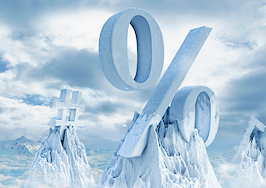As mortgage rates soared past the 4 percent threshold this week, they seemed to make a mockery of forecasts as leading economists didn’t expect to see rates climb so high until later this year or sometime next year.
But the rapid runup in rates as inflation numbers continue to come in hot illustrates that it’s bond market investors, rather than Fed policymakers, who exert the strongest immediate pull on the markets that drive daily and weekly trends in mortgage rates.
Since investors who buy mortgage-backed securities (MBS) are the ultimate source of funding for most mortgages, the rates are determined by MBS supply and demand. When investors are worried that interest rates will rise, demand for MBS falls. To keep money flowing into mortgage markets, lenders have to raise the rates offered to borrowers.
Investor sentiment can change at the drop of a hat, so mortgage rates could just as easily come back down in the days and weeks ahead — or plateau, or continue to rise. It largely depends on future inflation reports — and how the Fed, and investors, react to them.
This week’s spike in rates was largely driven by a report showing the consumer price index rose 7.5 percent in January — the largest annual increase since 1982 — and comments by St. Louis Fed Chair James Bullard that he’d like to see the Fed hike short-term rates four times during its next three meetings.
That would entail implementing the first half-point rate hike since 2000, a prospect that spooked bond markets and sent mortgage rates soaring above 4 percent Thursday.
Mortgage rates break 4 percent threshold
But nobody knows what the Fed will actually do, and other Fed officials — including Atlanta Fed President Raphael Bostic, Richmond Fed President Tom Barkin and San Francisco Fed President Mary Daly — are pushing back against Bullard’s hawkish view. That suggests markets may have “wrongly interpreted Bullard’s remarks as being more widely held than they are by Fed officials and leadership,” CNBC reports.
More clarity on the Fed’s intentions is unlikely until the Federal Open Market Committee concludes its next two-day meeting on March 16.
How the Fed influences mortgage rates
Unlike the short-term federal funds rate, which the Federal Reserve has tight control over through its 12 member banks, rates on mortgages and other long-term debt are determined by investor demand.
But that doesn’t mean the Fed doesn’t have an influence on long-term rates — particularly since during economic downturns it has become a player in the markets for government debt and mortgage backed securities, a technique pioneered during the 2007-09 financial crisis and recession, and referred to as “quantitative easing.”
Investors and economists are keeping a close eye on the three tools that the Federal Reserve has at its disposal to influence long-term rates:
The federal funds rate: The Fed’s primary tool for accelerating or decelerating economic growth, the federal funds rate is the interest rate banks charge each other to lend money overnight. At the beginning of the pandemic, the Fed dropped its target for the federal funds rate to zero percent to stimulate the economy by encouraging borrowing. When Fed policymakers raise the federal funds rate, that triggers a chain of events that can affect other short-term and long-term interest rates. In January, Fed policymakers indicated they were considering raising the federal funds rate six times in 2022, or 1.5 percentage points. Recent inflation reports suggesting that the Fed may have to take more drastic action to combat inflation have put pressure on long-term interest rates — even though the Fed is not expected to actually begin raising the federal funds rate until March.
Quantitative easing: Historically, the most drastic action the Fed can take in an emergency is to drop the federal funds rate to zero percent. It can’t make the federal funds rate negative. But during the 2007-09 financial crisis and recession, Fed policymakers felt more drastic action was needed. To bring down long-term interest rates, the Fed bought trillions of dollars in Treasurys and mortgage-backed securities — a new and controversial policy dubbed “quantitative easing.” While the Fed had intended to let the assets that it accumulated run off its balance sheet after the economy recovered, it hadn’t made much progress by the time the pandemic hit. During the pandemic, the Fed was buying $120 billion in Treasurys and mortgage-backed securities every month. It began tapering those purchases in November, a process that will be completed this month, clearing the way for the Fed to start raising the federal funds rate and trimming its balance sheet.
Balance sheet adjustments: After the economy started to recover from the 2007-09 recession, the Fed stopped adding to its holdings of Treasurys and mortgage-backed securities, but maintained its balance sheet by replacing assets as they matured. Even after they started raising the federal funds rate, policymakers waited almost two years before they started shrinking the Fed’s balance sheet. Today, with the Fed’s balance sheet now approaching $9 trillion, policymakers are unlikely to wait so long to start shrinking it by letting expiring Treasurys and mortgage-backed securities “run off” without replacing them. Minutes from the Federal Open Market Committee’s December meeting reveal that almost all members agree with Bullard that it would be a good idea to start running off the Fed’s balance sheet “at some point after the first increase in the target range for the federal funds rate,” and that the timing “would likely be closer to that of policy rate liftoff” than was the case in 2014. Once the Fed starts shrinking its balance sheet, it will no longer be a buyer of Treasurys and mortgage-backed securities, which could put upward pressure on long-term interest rates.
Fed quantitative easing approaching $9 trillion
Source: Board of Governors of the Federal Reserve System, Federal Reserve Bank of St. Louis.
While bond market investors make decisions based on their expectations of what the Fed will do in the future, the pace of the Fed’s future short-term interest rate hikes — and the decision on when to start shrinking its balance sheet — will be data dependent. If inflation numbers ease, the Fed could take a more relaxed approach to tightening, and mortgage rates and other long-term interest rates could plateau, or even come back down.
Many economists had expected that some factors driving inflation during the pandemic, such as supply chain disruptions, would be transitory.
Speaking before the Senate Banking Committee in November, Fed Chairman Jerome Powell came under fire from lawmakers, including Louisiana Republican Sen. John N. Kennedy, who scolded Powell that “it’s fair to say that the experts who have been advising you about the future rate of inflation have pretty much the same credibility as those late-night psychic hotlines you see on TV.”
At the hearing, Powell conceded that “it’s probably a good time to retire that that word [transitory] and try to explain more clearly what we mean,” when providing assurances that some of the factors driving inflation are only temporary.
Get Inman’s Extra Credit Newsletter delivered right to your inbox. A weekly roundup of all the biggest news in the world of mortgages and closings delivered every Wednesday. Click here to subscribe.













